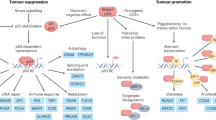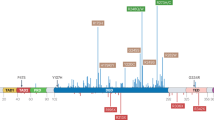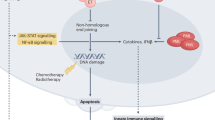Abstract
The aim of the study was to determine the incidence of p53 alterations by mutation, deletion or inactivation by mdm2 or human papillomavirus (HPV) infection in recurrent squamous cell cancer of the head and neck (SCCHN) refractory to radiotherapy. Twenty-two tumours were studied. The p53 status of each tumour was analysed by sequencing of exons 4–9 and by immunohistochemistry. Mdm2 expression was assessed by immunohistochemistry and HPV infection was assessed by polymerase chain reaction of tumour DNA for HPV 16, 18 and 33. Fifteen (68%) of the 22 tumours studied had p53 mutations, while seven had wild-type p53 sequence. p53 immunohistochemistry correlated with the type of mutation. HPV DNA was detected in 8 (36%) tumours and all were of serotype HPV 16. Of these, five were in tumours with mutant p53 and three were in tumours with wild-type p53. Mdm2 overexpression was detected in 11 (50%) tumours. Of these, seven were in tumours with mutant p53 and four were in tumours with wild-type p53. Overall, 21 of the 22 tumours had p53 alterations either by mutation, deletion or inactivation by mdm2 or HPV. In this study, the overall incidence of p53 inactivation in recurrent head and neck cancer was very high at 95%. The main mechanism of inactivation was gene mutation or deletion which occurred in 15 of the 22 tumours studied. In addition, six of the seven tumours with wild-type p53 sequence had either HPV 16 DNA, overexpression of mdm2 or both which suggested that these tumours had p53 inactivation by these mechanisms. This high incidence of p53 dysfunction is one factor which could account for the poor response of these tumours to radiotherapy and chemotherapy. Therefore, new therapies for recurrent SCCHN which either act in a p53 independent pathway, or which restore p53 function may be beneficial in this disease. © 2000 Cancer Research Campaign
Similar content being viewed by others
Article PDF
Change history
16 November 2011
This paper was modified 12 months after initial publication to switch to Creative Commons licence terms, as noted at publication
References
Bischoff JR, Kirn DH, Williams A, Heise C, Horn S and Muna M (1996) A mutant adenovirus which selectively replicates in tumour cells with nonfunctional p53. Science 274: 373–376
Bottger A, Bottger V, Sparks A, Liu WL, Howard SF and Lane DP (1997) Design of a synthetic mdm2-binding mini protein that activates the p53 response in vivo. Curr Biol 7: 860–869
Boyle JO, Koch W, Hruban RH, van der Riet P and Sidransky D (1993) The incidence of p53 mutations increases with progression of head and neck cancer. Cancer Res 53: 4477–4480
Brachman DG, Graves D, Vokes E, Beckett M, Haraf D and Montag A (1992) Occurrence of p53 gene deletions and human papilloma virus infection in human headand neck cancer. Cancer Res 52: 4832–4836
Buttitta F, Marchetti A, Gadducci A, Pellegrini S, Morganti M and Carnicelli V (1997) p53 alterations are predictive of chemoresistance and aggressiveness in ovarian carcinomas: a molecular and immunohistochemical study. Br J Cancer 75: 230–235
Catimel G, Verweij J, Mattijssen V, Hanauske A, Piccart M and Wanders J (1994) Docetaxel (taxotere): an active drug for the treatment of patients with advanced squamous cell carcinoma of the head and neck. Ann Oncol 5: 533–537
Czegledy J, Iosif C, Hanson BG, Evander M, Gergely L and Wadell G (1995) Can a test for E6/E7 transcripts of human papillomavirus type 16 serve as a diagnostic tool for the detection of micrometastases in cervical cancer. Int J Cancer (Pred Oncol) 64: 211–215
Chung KY, Mukhopadhyay T, Kim J, Casson A, Ro JY and Goepfert H (1993) Discordant p53 gene mutations in primary head and neck cancers and corresponding second primary cancers of the upper aerodigestive tract. Cancer Res 53: 1676–1683
Clavel M, Vermorken JB, Cognetti F, Cappelaere P, de Mulder PHM and Schornagel JH (1994) Randomised comparison of cisplatin, methotrexate, bleomycin and vincristine (CABO) versus cisplatin and 5-fluorouracil versus cisplatin in recurrent or metastatic squamous cell carcinoma of head and neck. Ann Oncol 5: 521–526
Clayman GL, El-Naggar AK, Roth JA, Zhang WW, Goepfert H and Taylor DL (1995) In vivo molecular therapy with p53 adenovirus for microscopic residual head and neck squamous carcinoma. Cancer Res 55: 1–6
Clayman GL, El-Naggar AK, Merritt J, Bruso P, Roth JA and Lippman S (1998) Adenovirus mediated p53 gene transfer in patients with advanced recurrent head and neck squamous cell carcinoma. J Clin Oncol 16: 2221–2232
Crook T, Wrede D and Vousden KH (1991) p53 point mutations in HPV negative human cervical carcinoma cell lines. Oncogene 6: 873–875
Cutilli T, Papola F, Di Emidio P, Leocata P and Corbacelli A (1998) p53 mutations and chemoresistance in oromaxillofacial squamous cell carcinomas. The results of a molecular genetics study of p53 in metastatic oromaxillofacial tumours and an evaluation of the response to neoadjuvant chemotherapeutic treatment. Minerva Stomatol 47: 1–9
Forastiere AA (1994) Overview of platinum chemotherapy in head and neck cancer. Semin Oncol 21: 20–27
Ganly I, Kirn D, Rodriguez GI, Soutar D, Eckhardt G and Otto R (1997) Phase I trial of intratumoural injection with an E1B attenuated adenovirus, ONYX-015, in patients with recurrent p53(–) head and neck cancer. J Clin Oncol 16: 1362
Girod SC, Cesarz D, Fischer U and Krueger GR (1995) Detection of p53 and mdm2 protein expression in head and neck carcinogenesis. Anticancer Res 15: 1453–1457
Haraf DJ, Nodzenski E, Brachman D, Mick R, Montag A and Graves D (1996) Human papilloma virus and p53 in head and neck cancer: clinical correlates and survival. Clin Cancer Res 2: 755–762
Haupt Y, Maya R, Kazaz A and Oren M (1997) Mdm2 promotes the rapid degradation of p53. Nature 387: 296–299
Heise H, Sampson-Johannes A, Williams A, McCormack F, Von Hoff DD and Kirn DH (1997) Onyx-015, an E1B gene-attenuated adenovirus, causes tumour specific cytolysis and antitumoural efficacy that can be augmented by standard chemotherapeutic agents. Nat Med 3: 639–645
Huang LC, Clarkin KC and Wahl GM (1996) Sensitivity and selectivity of the DNA damage sensor responsible for activating p53-dependent G1 arrest. Proc Natl Acad Sci USA 94: 4827–4832
Jones KR, Lodge-Rigal RD, Reddick RL, Tudor GE and Shockley WW (1992) Prognostic factors in the recurrence of stage I and II squamous cell cancer of the oral cavity. Arch Otolaryngol Head Neck Surg 118: 483–485
Kao CC, Yew PR and Berk AJ (1990) Domains required for in vitro association between the cellular p53 and the adenovirus 2 E1B 55K proteins. Virology 179: 806–814
Koh JY, Cho NP, Kong G, Lee JD and Yoon K (1998) p53 mutations and human papilloma DNA in oral squamous cell cancer: correlation with apoptosis. Br J of Cancer 78: 354–359
Lechner MS (1992) Human papillomavirus E6 proteins bind p53 in vivo and abrogate p53-mediated repression of transcription. Embo J 11: 3045–3052
Levine AJ (1990) The p53 protein and its interactions with the oncogene products of the small DNA tumour viruses. Virology 177: 419–426
Liu TJ, Zhang WW, Taylor DL, Roth JA, Goepfert H and Clayman GL (1994) Growth suppression of human head and neck cancer cells by the introduction of a wild type p53 gene via a recombinant adenovirus. Cancer Res 54: 3662–3667
Liu TU, El-Nagger AK, McDonnell TJ, Steck KD, Wang M and Taylor DL (1995) Apoptosis induction mediated by wild-type p53 adenoviral gene transfer in squamous cell carcinoma of the head and neck. Cancer Res 55: 117–122
Lowe SW, Riley HE, Jack T and Honsman DE (1993) p53 dependent apoptosis modulates the cytotoxicity of anticancer agents. Cancer Res 54: 3500–3505
Mao EJ, Schwartz SM, Daling JR, Oda D, Tickman L and Beckmann AM (1996) Human papilloma viruses and p53 mutations in normal pre-malignant and malignant oral epithelia. Int J Cancer 69: 152–158
Matsumura T, Yoshihama Y, Kimura T, Shintani S and Alcalde RE (1996) p53 and mdm2 expression in oral squamous cell carcinoma. Oncology 53: 308–312
McIlwrath AJ, Vasey PA, Ross GM and Brown R (1994) Cell cycle arrests and radiosensitivity of human tumour cell lines: dependence on wild type p53 for radiosensitivity. Cancer Res 54: 3718–3722
McKaig RG, Baric RS and Olshan AF (1998) Human papillomavirus and head and neck cancer: epidemiology and molecular biology. Head Neck 20: 250–265
Miguel RE, Villa LL, Cordeiro AC, Prado JC, Sobrinho JS and Kowalski LP (1998) Low prevalence of human papillomavirus in a geographic region with a high incidence of head and neck cancer. Am J Surg 176: 428–429
Nabel GJ, Nabel EG, Yang ZY, Fox BA, Plautz GE and Gao X (1993) Direct gene transfer with DNA-liposome complexes in melanoma: expression, biological activity, and lack of toxicity in humans. Proc Natl Acad Sci USA 90: 11307–11311
Nickers P, Kunkler I and Scalliet P (1997) Modern brachytherapy: current state and future prospects. Eur J Cancer 33: 1747–1751
Oliner JD, Kinzler KW, Meltzer PS, George D and Vogelstein B (1992) Amplification of a gene encoding a p53 associated protein in human sarcomas. Nature 358: 80–83
Olshan AF, Weissler MC, Pei H and Conway K (1997) p53 mutations in head and neck cancer: new data and evaluation of mutational spectra. Cancer Epidemiol Biomarkers Prev 6: 499–504
Park T, Wilezynski SP, Paquette RL, Miller CW and Koeffler HP (1994) p53 mutations in HPV negative cervical carcinoma. Oncogene 9: 205–210
Paz IB, Cook N, Odom-Maryon T, Xie Y and Wilczynski SP (1997) Human papillomavirus (HPV) in head and neck cancer. An association of HPV16 with squamous cell carcinoma of Waldeyer’s ring. Cancer 79: 595–604
Pruneri G, Pignataro L, Carboni N, Luminari S, Capaccio P and Neri A (1997) Mdm2 oncoprotein overexpression in laryngeal squamous cell carcinoma: association with wild-type p53 accumulation. Mod Pathol 10: 785–792
Righetti SC, Torre GD, Pilotti S, Menard S, Ottone F and Colnaghi MA (1996) A comparitive study of p53 gene mutations, protein accumulation and response to cisplatin-based chemotherapy in advanced ovarian carcinoma. Cancer Res 56: 689–693
Roth JA (1996) Retrovirus mediated wild type p53 gene transfer to tumours of patients with lung cancer. Nature Med 2: 985–991
Scheffner M, Werness BA, Huibregtse JM, Levine AJ and Howley PM (1990) The E6 oncoprotein encoded by human papillomavirus types 16 and 18 promotes the degradation of p53. Cell 63: 1129–1136
Stoler MM, Rhodes CR, Whitbeck A, Wolinsky SM, Chow LT and Broker TR (1992) Human papillomavirus type 16 and 18 gene expression in cervical neoplasms. Hum Pathol 23: 117–128
Snow GB (1989). Evaluation and staging of the patient with head and neck cancer. Churchill Livingstone: New York 17–38
Yeudall WA and Campo MS (1991) Human papillomavirus DNA in biopsies of oral tissues. J Gen Virol 72: 173–176
Yoshikawa H, Kawana T, Kitagawa K, Mizuno M, Yoshikura H and Iwamoto A (1991) Detection and typing of multiple genital human papillomaviruses by DNA amplification with consensus primers. Jpn J Cancer Res 82: 524–531
zur Hausen H (1994) Molecular pathogenesis of cancer of the cervix and its causation by specific human papillomavirus types. Curr Topics Microbiol Immunol 186: 131–156
Author information
Authors and Affiliations
Rights and permissions
From twelve months after its original publication, this work is licensed under the Creative Commons Attribution-NonCommercial-Share Alike 3.0 Unported License. To view a copy of this license, visit http://creativecommons.org/licenses/by-nc-sa/3.0/
About this article
Cite this article
Ganly, I., Soutar, D., Brown, R. et al. p53 alterations in recurrent squamous cell cancer of the head and neck refractory to radiotherapy. Br J Cancer 82, 392–398 (2000). https://doi.org/10.1054/bjoc.1999.0932
Received:
Revised:
Accepted:
Published:
Issue date:
DOI: https://doi.org/10.1054/bjoc.1999.0932
Keywords
This article is cited by
-
Epithelial-to-mesenchymal transition status correlated with ultrastructural features, and TP53 mutation in patient-derived oral cancer cell lines
Molecular Biology Reports (2023)
-
Head and Neck Squamous Cell Cancer: Biology (II) and Translational Methods
Indian Journal of Otolaryngology and Head & Neck Surgery (2007)
-
Clinical research results with dl1520 (Onyx-015), a replication-selective adenovirus for the treatment of cancer: what have we learned?
Gene Therapy (2001)
-
Genetic alterations in head and neck cancer: interactions among environmental carcinogens, cell cycle control, and host DNA repair
Current Oncology Reports (2001)



